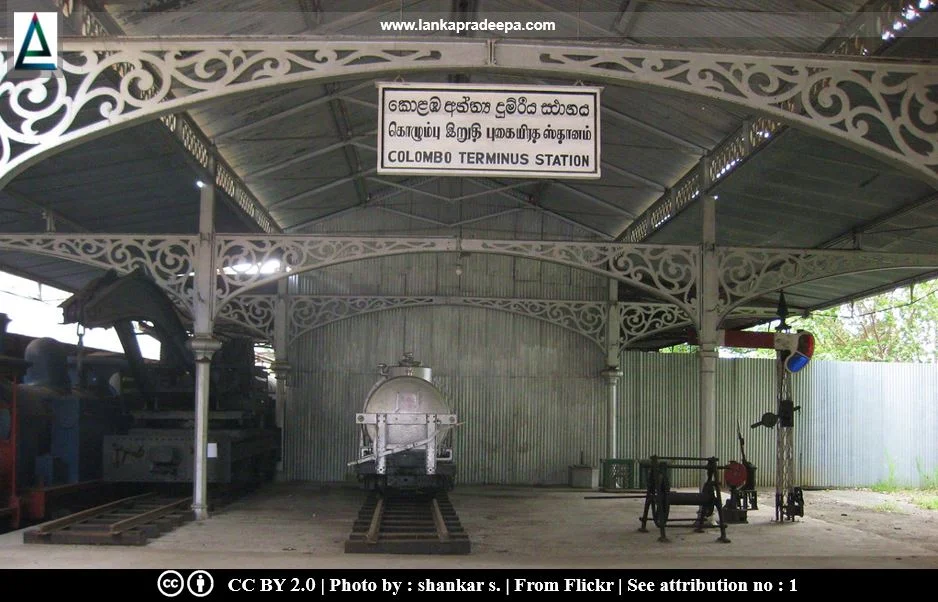
The Colombo Terminus Railway Station (Sinhala: කොළඹ අන්ත්ය දුම්රිය ස්ථානය) is an abandoned railway station in Colombo, Sri Lanka. It is considered as the first railway station built in the country by the British who pioneered in the beginning of the railway service in Sri Lanka (Rajapakshe et al., 2018).
History
In the 19th century, the British rulers commenced the railway service in Sri Lanka for planters to facilitate the transportation of their harvest from inland to the seaport located in Colombo (Kesavan et al., 2015). On 3 August 1858, the then Ceylon Governor, Henry George Ward (1855-1860 A.D.) commenced the construction of the first railway line in the country to be run between Colombo and Ambepussa (Abeysinghe, 2016). After the completion, the first train transportation happened between
Colombo and Ambepussa on 27 December 1864 (Abeysinghe, 2016).
Besides the stations at Colombo (the Colombo Terminus
Railway Station) and Ambepussa, three more stations at Mahara (present Ragama), Henarathgoda (present Gampaha) and Veyangoda were completed along the railway line in 1866 (CGR, 1964). In 1867, the railway station at Peradeniya was built.
Colombo Terminus Railway Station
This railway station was built in the 1858-1865 period by a contractor named William Frederick Faviell (1822-1902) following the architecture of the Manchester Railway Station in England (Manathunga, 2016; Rajapakshe et al., 2018). The first train in Sri Lanka commenced its journey from this station to the railway station at Ambepussa in 1864 (Abeysinghe, 2016; Manathunga, 2016; Rajapakshe et al., 2018).
However, after the construction of the Maradana Railway Station in 1908, the activities of the Colombo Terminus Railway Station were stopped (Manathunga, 2016). The station was completely neglected after the construction of the present Colombo Fort Railway Station (Manathunga, 2016).
The station
Initially, the railway station consists of an office, a train platform, two store rooms, and a quarter for officials (Rajapakshe et al., 2018). The office is presently used as a museum and one can approach to the train platform through this office building (Rajapakshe et al., 2018). At the beginning, the train platform was about 50 m in length and after the addition of another platform, the length increased up to 108 m (Manathunga, 2016; Rajapakshe et al., 2018). The roof of the platform was held on a frame made of cast iron imported from England (Rajapakshe et al., 2018).
A protected monument
The Old Fort Railway Station in Maradana in the Divisional Secretary’s
Division of Colombo is an archaeological protected monument, declared by a government gazette notification published on 18 June 1999.
Attribution
References
1) Abeysinghe, A.H.M.S.P., 2016. ශ්රී ලංකාවේ දුම්රිය කාර්මික පුරාවිද්යාව; නව මානයක් කරා රැගෙන යමු. Puraveda 2016.
2) CGR, 1964. Ceylon Government Railway : One hundred years, 1864-1964, Colombo. p.19.
3) Kesavan, R.A., Chandrakumar, C., Kulatunga, A.K., Gowrynathan, J., Rajapaksha, R.T.D., Senewiratne, R.K.G.D.M. and Laguleshwaran, D., 150 Years of Sri Lankan Railways: Evaluation of the Services from Employee and Customer Perspectives. International Journal of Emerging Technology and Advanced Engineering. Volume 5, Issue 5.
4) Manathunga, S. B., 2016. Pauranika Sthana Saha Smaraka: Kolamba Distrikkaya (In Sinhala). Department of Archaeology (Sri Lanka). ISBN: 955-9159-39-9. pp.60-61.
5) Rajapakshe, S.; Bandara, T. M. C.; Vanninayake, R. M. B. T. A. B. (Editors), 2018. Puravidya Sthana Namavaliya: Kolamba Distrikkaya (In Sinhala). Vol. I. Department of Archaeology (Sri Lanka). ISBN: 978-955-7457-19-2. pp.37-38.
6) The Gazette of the Democratic Socialist Republic of Sri Lanka. No: 1085. 18 June 1999.
2) CGR, 1964. Ceylon Government Railway : One hundred years, 1864-1964, Colombo. p.19.
3) Kesavan, R.A., Chandrakumar, C., Kulatunga, A.K., Gowrynathan, J., Rajapaksha, R.T.D., Senewiratne, R.K.G.D.M. and Laguleshwaran, D., 150 Years of Sri Lankan Railways: Evaluation of the Services from Employee and Customer Perspectives. International Journal of Emerging Technology and Advanced Engineering. Volume 5, Issue 5.
4) Manathunga, S. B., 2016. Pauranika Sthana Saha Smaraka: Kolamba Distrikkaya (In Sinhala). Department of Archaeology (Sri Lanka). ISBN: 955-9159-39-9. pp.60-61.
5) Rajapakshe, S.; Bandara, T. M. C.; Vanninayake, R. M. B. T. A. B. (Editors), 2018. Puravidya Sthana Namavaliya: Kolamba Distrikkaya (In Sinhala). Vol. I. Department of Archaeology (Sri Lanka). ISBN: 978-955-7457-19-2. pp.37-38.
6) The Gazette of the Democratic Socialist Republic of Sri Lanka. No: 1085. 18 June 1999.
Location Map
This page was last updated on 21 August 2022

